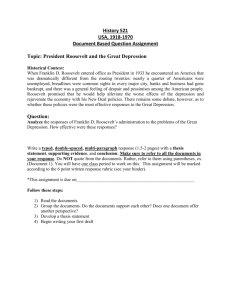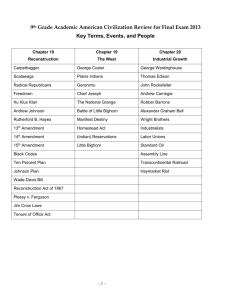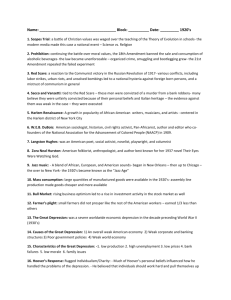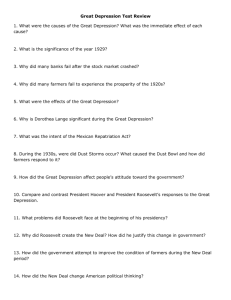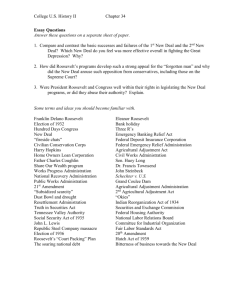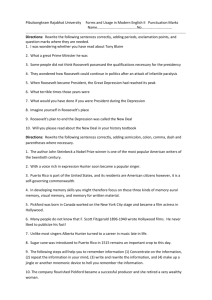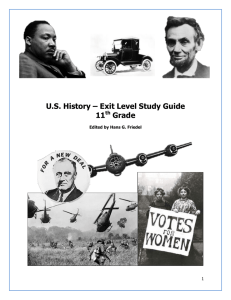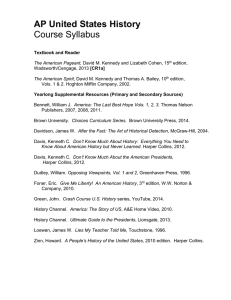APUSH Period Guide 7 (1890
advertisement
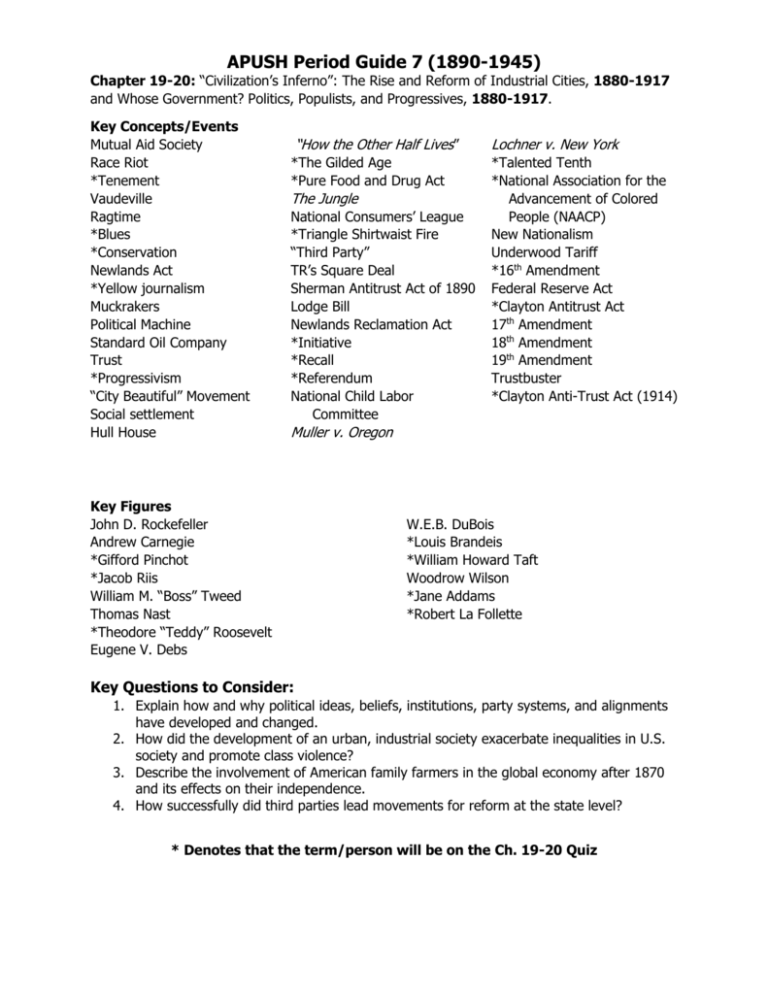
APUSH Period Guide 7 (1890-1945) Chapter 19-20: “Civilization’s Inferno”: The Rise and Reform of Industrial Cities, 1880-1917 and Whose Government? Politics, Populists, and Progressives, 1880-1917. Key Concepts/Events Mutual Aid Society Race Riot *Tenement Vaudeville Ragtime *Blues *Conservation Newlands Act *Yellow journalism Muckrakers Political Machine Standard Oil Company Trust *Progressivism “City Beautiful” Movement Social settlement Hull House “How the Other Half Lives” *The Gilded Age *Pure Food and Drug Act The Jungle National Consumers’ League *Triangle Shirtwaist Fire “Third Party” TR’s Square Deal Sherman Antitrust Act of 1890 Lodge Bill Newlands Reclamation Act *Initiative *Recall *Referendum National Child Labor Committee Lochner v. New York *Talented Tenth *National Association for the Advancement of Colored People (NAACP) New Nationalism Underwood Tariff *16th Amendment Federal Reserve Act *Clayton Antitrust Act 17th Amendment 18th Amendment 19th Amendment Trustbuster *Clayton Anti-Trust Act (1914) Muller v. Oregon Key Figures John D. Rockefeller Andrew Carnegie *Gifford Pinchot *Jacob Riis William M. “Boss” Tweed Thomas Nast *Theodore “Teddy” Roosevelt Eugene V. Debs W.E.B. DuBois *Louis Brandeis *William Howard Taft Woodrow Wilson *Jane Addams *Robert La Follette Key Questions to Consider: 1. Explain how and why political ideas, beliefs, institutions, party systems, and alignments have developed and changed. 2. How did the development of an urban, industrial society exacerbate inequalities in U.S. society and promote class violence? 3. Describe the involvement of American family farmers in the global economy after 1870 and its effects on their independence. 4. How successfully did third parties lead movements for reform at the state level? * Denotes that the term/person will be on the Ch. 19-20 Quiz Chapter 21: An Emerging World Power, 1890-1918. Key Concepts/Events *Imperialism *White Man’s Burden American Exceptionalism Yellow Journalism Teller Amendment *Platt Amendment San Juan Hill *Rough Riders U.S.S. Maine *“Remember the Maine” Spanish-American War of 1898 Insular Cases Open Door Policy Panama Canal *“Gentleman’s Agreement” (1907) Philippine-American War Anti-Imperialist League Roosevelt Corollary Big Stick Policy Isolationism/Neutrality Lusitania *Zimmermann Telegram War Industries Board National War Labor Board Committee on Public Information Four-Minute-Men Espionage Sedition Act of 1918 “Dollar vs Moral Diplomacy” Triple Alliance Triple Entente (Allies) *American Expeditionary Forces (AEF) Key Figures William Randolph Hearst *Joseph Pulitzer Henry Cabot Lodge Alfred Mahan Sanford B. Dole *Queen Liliuokalani William McKinley Grover Cleveland Theodore “Teddy” Roosevelt *Emilio Aguinaldo Great Migration *Battle of Argonne Forest Battle of Verdun Machine Gun Poison Gas Tanks Airplanes *Trench Warfare Schenck v. U.S. *Fourteen Points Influenza Pandemic *National Woman’s Party (NWP) National American Woman Suffrage Association (NAWSA) League of Nations *Treaty of Versailles Alice Paul *Carrie Chapman Catt *Archduke Franz Ferdinand *John J. “Blackjack” Pershing Pancho Villa Woodrow Wilson *Sergeant Alvin York Key Questions to Consider: 1. What ideas and interests motivated the United States to create an empire in the late nineteenth century? 2. Compare the arguments for and against U.S. imperialism. Be sure to consider the views of President McKinley and Emilio Aguinaldo. 3. Explain the impact of American racial attitudes and practices on other nations during the age of empire. * Denotes that the term/person will be on the Ch. 21 Quiz Chapter 22 & 23: Cultural Conflict, Bubble, and Bust, 1819-1932 and Managing the Great Depression, Forging the New Deal, 1929-1939 Key Concepts/Events Red Scare *Palmer Raids Teapot Dome Dollar Diplomacy *Prohibition American Civil Liberties Union Scopes Trial Nativism American Indian Citizenship Act of 1924 Ku Klux Klan *Harlem Renaissance Jazz Universal Negro Improvement Association *Pan-Africanism Lost Generation Consumer Credit Hollywood *Flapper Bonus Army *Fireside Chats Hundred Days *“Alphabet Soup” Glass-Steagall Act Agricultural Adjustment Act National Recovery Administration Public Works Administration *Civilian Conservation Corps Federal Housing Administration Securities and Exchange Commission Welfare State Key Figures Mitchell Palmer *Nicola Sacco and Bartolomeo Vanzetti *Louis Armstrong Warren G. Harding *Clarence Darrow William Jennings Bryan Henry Ford Glenn Curtiss *Marcus Garvey *Charles A. Lindbergh Wagner Act *Social Security Act Classical Liberalism Works Progress Administration Roosevelt Recession Indian Reorganization Act Dust Bowl *Tennessee Valley Authority Rural Electrification Administration *Federal Deposit Insurance Corporation Hoovervilles *New Deal 2nd New Deal *Herbert Hoover Franklin Delano Roosevelt *Father Charles Coughlin Huey Long Frances Perkins *Eleanor Roosevelt * Denotes that the term/person will be on the Ch. 22-23 Quiz Chapter 24: The World at War, 1937-1945. Key Concepts/Events Fascism *Appeasement Good Neighbor Policy *Isolationist Nazi Party Allied Powers Axis Powers Rome-Berlin Axis *Cash and Carry Policy Lend-Lease Act Neutrality Act of 1935 Atlantic Charter Rhineland *Sudetenland *Battle of Britain Popular Front Munich Conference America First Committee Key Figures Eleanor Roosevelt *General George S. Patton Admiral Chester Nimitz General Omar Bradley General Dwight D. Eisenhower General George Marshall *General Douglas MacArthur *Winston Churchill *Benito Mussolini Erwin Rommel Four Freedoms *Pearl Harbor War Powers Act War Production Bond *Victory Gardens Rations Revenue Act *Navajo Code Talkers Executive Order 8802 WAVES Servicemen’s Readjustment Act (1944) *Zoot Suit Riots *Executive Order 9066 Korematsu v. U.S. (1944) *Battle of the Bulge *D-Day/Invasion of Normandy *Bataan Death March Aleutian Islands Battle of Coral Sea Battle of Midway *Island Hopping *Battle of Iwo Jima Battle for Okinawa Potsdam Conference Holocaust Manhattan Project Hiroshima *Nagasaki *V-E Day V-J Day Bracero Program *Tuskegee Airmen Flying Tigers *Office of War Information A. Philip Randolph *Doris Miller Emperor Hirohito Adolf Hitler Joseph Stalin *Audie Murphy *Vernon J. Baker * Denotes that the term/person will be on the Ch. 24 Quiz PERIOD 7: 1890–1945 An increasingly pluralistic United States faced profound domestic and global challenges, debated the proper degree of government activism, and sought to define its international role. Key Concept 7.1: Governmental, political, and social organizations struggled to address the effects of large-scale industrialization, economic uncertainty, and related social changes such as urbanization and mass migration. I. The continued growth and consolidation of large corporations transformed American society and the nation’s economy, promoting urbanization and economic growth, even as business cycle fluctuations became increasingly severe. (WOR-3) (ID-7) (WXT-3) (WXT-5) (POL-3) A. Large corporations came to dominate the U.S. economy as it increasingly focused on the production of consumer goods, driven by new technologies and manufacturing techniques. B. The United States continued its transition from a rural, agricultural society to an urban, industrial one, offering new economic opportunities for women, internal migrants, and international migrants who continued to flock to the United States. C. Even as economic growth continued, episodes of credit and market instability, most critically the Great Depression, led to calls for the creation of a stronger financial regulatory system. II. Progressive reformers responded to economic instability, social inequality, and political corruption by calling for government intervention in the economy, expanded democracy, greater social justice, and conservation of natural resources. (WXT-6) (WXT-7) (WXT-8) (POL-3) (ENV-5) (CUL-5) A. In the late 1890s and the early years of the 20th century, journalists and Progressive reformers — largely urban and middle class, and often female — worked to reform existing social and political institutions at the local, state, and federal levels by creating new organizations aimed at addressing social problems associated with an industrial society. B. Progressives promoted federal legislation to regulate abuses of the economy and the environment, and many sought to expand democracy. III. National, state, and local reformers responded to economic upheavals, laissez-faire capitalism, and the Great Depression by transforming the United States into a limited welfare state. (WXT-8) (POL-2) (POL-4) (ID-3) (CUL-5) A. The liberalism of President Franklin Roosevelt’s New Deal drew on earlier progressive ideas and represented a multifaceted approach to both the causes and effects of the Great Depression, using government power to provide relief to the poor, stimulate recovery, and reform the American economy. B. Radical, union, and populist movements pushed Roosevelt toward more extensive reforms, even as conservatives in Congress and the Supreme Court sought to limit the New Deal’s scope. C. Although the New Deal did not completely overcome the Depression, it left a legacy of reforms and agencies that endeavored to make society and individuals more secure, and it helped foster a long-term political realignment in which many ethnic groups, African Americans, and working-class communities identified with the Democratic Party. Key Concept 7.2: A revolution in communications and transportation technology helped to create a new mass culture and spread “modern” values and ideas, even as cultural conflicts between groups increased under the pressure of migration, world wars, and economic distress. I. New technologies led to social transformations that improved the standard of living for many while contributing to increased political and cultural conflicts. (ID-6) (ID-8) (WXT-3) (WXT-5) (CUL-3) (CUL-6) (CUL-7) A. New technologies contributed to improved standards of living, greater personal mobility, and better communications systems. B. Technological change, modernization, and changing demographics led to increased political and cultural conflict on several fronts: tradition versus innovation, urban versus rural, fundamentalist Christianity versus scientific modernism, management versus labor, native-born versus new immigrants, white versus black, and idealism versus disillusionment. C. The rise of an urban, industrial society encouraged the development of a variety of cultural expressions for migrant, regional, and African American artists (expressed most notably in the Harlem Renaissance movement); it also contributed to national culture by making shared experiences more possible through art, cinema, and the mass media. II. The global ramifications of World War I and wartime patriotism and xenophobia, combined with social tensions created by increased international migration, resulted in legislation restricting immigration from Asia and from southern and eastern Europe. (ID-6) (WOR-4) (PEO-2) (PEO-6) (PEO-7) (POL-7) (WXT-6) A. WW I created a repressive atmosphere for civil liberties, resulting in official restrictions on freedom of speech. B. As labor strikes and racial strife disrupted society, the immediate postwar period witnessed the first “Red Scare,” which legitimized attacks on radicals and immigrants. C. Several acts of Congress established highly restrictive immigration quotas, while national policies continued to permit unrestricted immigration from nations in the Western Hemisphere, especially Mexico, in order to guarantee an inexpensive supply of labor. III. Economic dislocations, social pressures, and the economic growth spurred by World Wars I and II led to a greater degree of migration within the United States, as well as migration to the United States from elsewhere in the Western Hemisphere. (ID-6) (ID-8) (PEO-3) (WOR-4) A. Although most African Americans remained in the South despite legalized segregation and racial violence, some began a “Great Migration” out of the South to pursue new economic opportunities offered by World War I. B. Many Americans migrated during the Great Depression, often driven by economic difficulties, and during World Wars I and II, as a result of the need for wartime production labor. C. Many Mexicans, drawn to the United States by economic opportunities, faced ambivalent government policies in the 1930s and 1940s. Key Concept 7.3: Global conflicts over resources, territories, and ideologies renewed debates over the nation’s values and its role in the world while simultaneously propelling the United States into a dominant international military, political, cultural, and economic position. I. Many Americans began to advocate overseas expansionism in the late 19th century, leading to new territorial ambitions and acquisitions in the Western Hemisphere and the Pacific. (WOR-6) (WOR-7) (ENV-5) (POL-6) A. The perception in the 1890s that the western frontier was “closed,” economic motives, competition with other European imperialist ventures of the time, and racial theories all furthered arguments that Americans were destined to expand their culture and norms to others, especially the nonwhite nations of the globe. B. The American victory in the Spanish-American War led to the U.S. acquisition of island territories, an expanded economic and military presence in the Caribbean and Latin America, engagement in a protracted insurrection in the Philippines, and increased involvement in Asia. C. Questions about America’s role in the world generated considerable debate, prompting the development of a wide variety of views and arguments between imperialists and anti-imperialists and, later, interventionists and isolationists. II. World War I and its aftermath intensified debates about the nation’s role in the world and how best to achieve national security and pursue American interests. (WOR-4) (WOR-7) (ID-3) (POL-6) A. After initial neutrality in World War I, the nation entered the conflict, departing from the U.S. foreign policy tradition of noninvolvement in European affairs in response to Woodrow Wilson’s call for the defense of humanitarian and democratic principles. B. Although the American Expeditionary Force played a relatively limited role in the war, Wilson was heavily involved in postwar negotiations, resulting in the Treaty of Versailles and the League of Nations, both of which generated substantial debate within the United States. C. In the years following World War I, the United States pursued a unilateral foreign policy that used international investment, peace treaties, and select military intervention to promote a vision of international order, even while maintaining U.S. isolationism, which continued to the late 1930s. III. The involvement of the United States in World War II, while opposed by most Americans prior to the attack on Pearl Harbor, vaulted the United States into global political and military prominence and transformed both American society and the relationship between the United States and the rest of the world. (WOR-4)(WOR-7) (ID-3) (ID-6) (POL-5) A. The mass mobilization of American society to supply troops for the war effort and a workforce on the home front ended the Great Depression and provided opportunities for women and minorities to improve their socioeconomic positions. B. Wartime experiences, such as the internment of Japanese Americans, challenges to civil liberties, debates over race and segregation, and the decision to drop the atomic bomb raised questions about American values. C. The United States and its allies achieved victory over the Axis powers through a combination of factors, including allied political and military cooperation, industrial production, technological and scientific advances, and popular commitment to advancing democratic ideals. D. The dominant American role in the Allied victory and postwar peace settlements, combined with the war-ravaged condition of Asia and Europe, allowed the United States to emerge from the war as the most powerful nation on earth.

